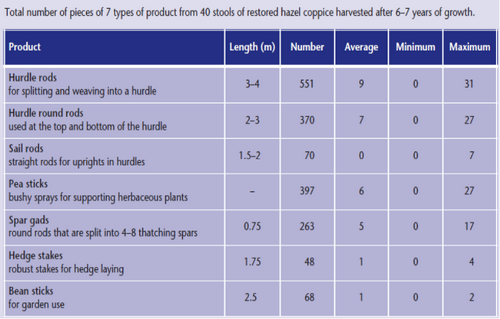Hazel (Corylus avellana)
 Hazel makes excellent dense cover for birds, and is often used as an understory in conservation woodlands for that purpose. It has been used since prehistory as a coppicing tree, and provides roundwood poles which can be used for wattle fencing, shelters houses, and gates. Coppice poles are suitable for use from age 3- 4 years, but anything up to 7 years can still be useful. Coppice woodlands using hazel for roundwood are often split into zones, and a rotation is employed to provide a continual harvest of poles (for 7 year poles, seven stands of hazel are necessary). Thus coppice woodlands represent a kind of age diverse succession which permits a variety of light, vegetation, cover and water scenarios. They are excellent for wildlife and can form a significant part of a woodland management strategy.
Hazel makes excellent dense cover for birds, and is often used as an understory in conservation woodlands for that purpose. It has been used since prehistory as a coppicing tree, and provides roundwood poles which can be used for wattle fencing, shelters houses, and gates. Coppice poles are suitable for use from age 3- 4 years, but anything up to 7 years can still be useful. Coppice woodlands using hazel for roundwood are often split into zones, and a rotation is employed to provide a continual harvest of poles (for 7 year poles, seven stands of hazel are necessary). Thus coppice woodlands represent a kind of age diverse succession which permits a variety of light, vegetation, cover and water scenarios. They are excellent for wildlife and can form a significant part of a woodland management strategy.
Pear Wood Nature Reserve - Rosemary Etheridge & Claire Abbott

From; Harmer, Ralf. Restoration of Neglected Hazel Coppice.
Forest Research/ Forestry Commission. March 2004.

Hazel is dioecious, meaning male and female flowers are found on the same tree. In early spring, the yellow male catkins open where they can be colloquially referred to as “lambs tails”. The female flowers appear on the same branches as tiny pink/crimson tufts. The earliest lambs tails I ever saw was during a period of miserable January weather, where it turned a somewhat drab tree into impressive sprays of golden flowers.
Hazel nuts are easy to harvest, and may be eaten as roasted nuts, but are otherwise difficult to utilise, on account of their toughness and tannin content. They may be successfully used as flour after cooking and pulverising. From the point of view of “obtaining a yield” making flour is quite labour intensive. Kentish cobnuts seem to be the easiest and most tasty variety of hazel nuts for roasting.
Common Hazel Leaves and Nuts, Permission under Wiki Creative Commons license, photo User:MPF

Not all woodland jobs require land ownership. Many landowners don’t have time or the skills to manage small parcels of woodland, and have allowed their woods to fall into disuse. You can contact them and offer to manage their woods, for the price of deadwood, fuelwood, or round hazel poles. As a trainee woodsman and hedgelayer in the 1990’s, I had the opportunity to work in a variety of coppice woodlands in Sussex using primarily hazel, hornbeam and sweet chestnut. As part of my work I helped manage a coppice which was cultivated by a walking stick maker who used hazel and hornbeam to make a variety of roundwood sticks. One of his interesting tricks was to wind new shoots of hazel round a spiral wire in order to make the wood grow into a variety of gnarled shapes and bulges.
If working outdoors is something you have yearned for, signing up with ADL can be a manageable way to build your CV and transition to working with conservation bodies or charities, arboricultural agencies, or even starting a self employed career as a woodsperson, tree surgeon, artisan country crafts practitioner, or groundsperson. Photo: Credit: Andy Patterson
References:
Harmer, Ralf. Restoration of Neglected Hazel Coppice. Forest Research/ Forestry Commission. March 2004.
Oaks, Rebecca. Coppicing and Coppice Crafts: A Comprehensive Guide. The Crowood Press Ltd, 2010.